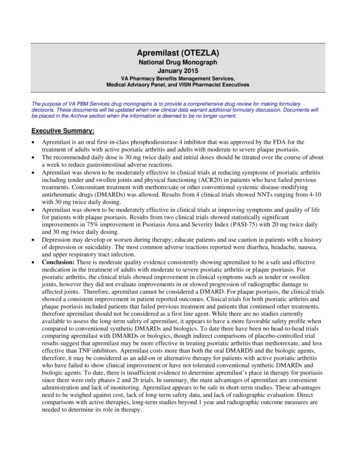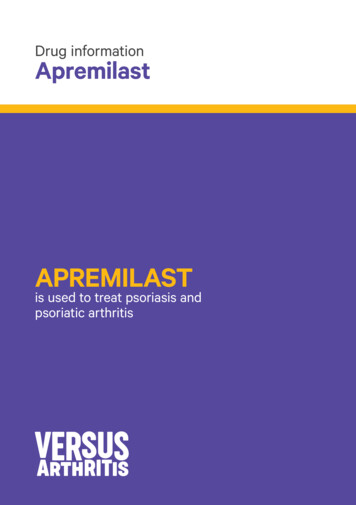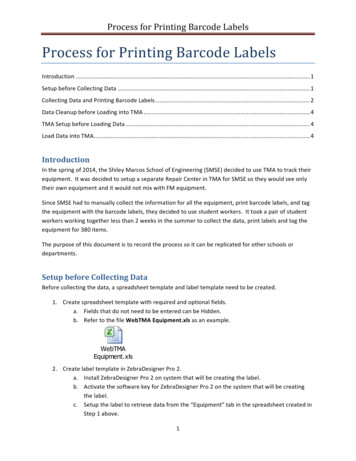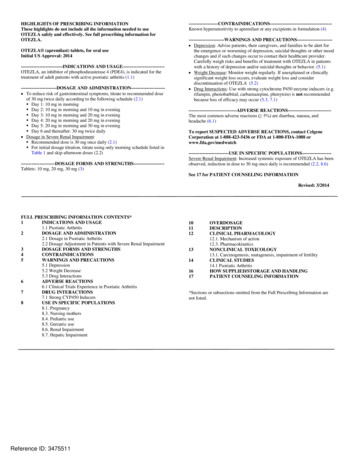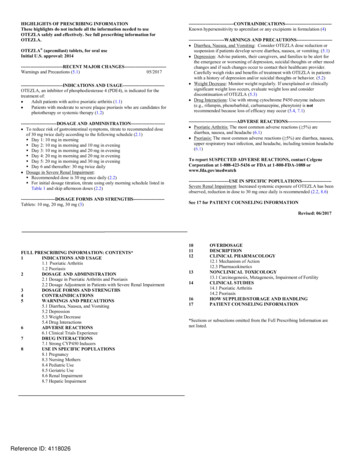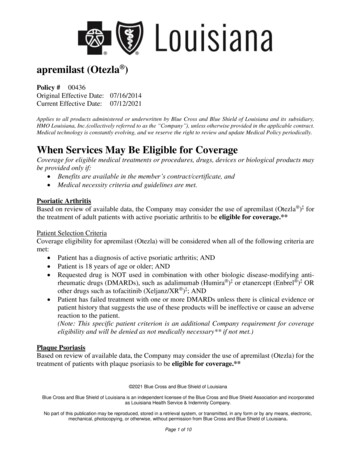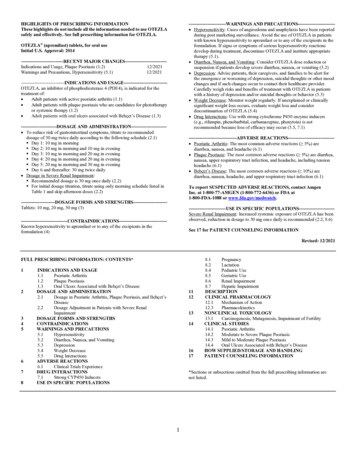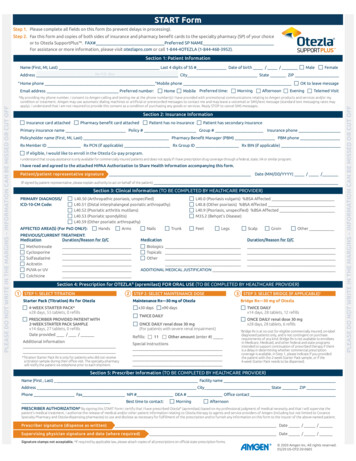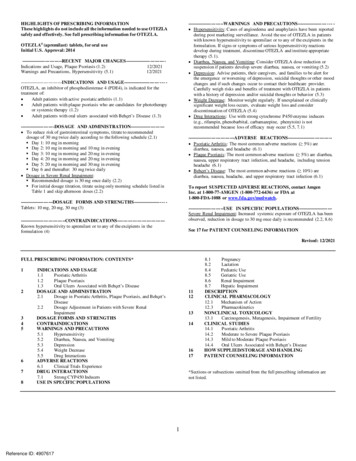
Transcription
HIGHLIGHTS OF PRESCRIBING INFORMATIONThese highlights do not include all the information needed to use OTEZLAsafely and effectively. See full prescribing information for OTEZLA.------------------------WARNINGS AND PRECAUTIONS-------------------- --- Hypersensitivity: Cases of angioedema and anaphylaxis have been reportedduring post marketing surveillance. Avoid the use of OTEZLA in patientswith known hypersensitivity to apremilast or to any of the excipients in theformulation. If signs or symptoms of serious hypersensitivity reactionsdevelop during treatment, discontinue OTEZLA and institute appropriatetherapy (5.1). Diarrhea, Nausea, and Vomiting: Consider OTEZLA dose reduction orsuspension if patients develop severe diarrhea, nausea, or vomiting (5.2) Depression: Advise patients, their caregivers, and families to be alert forthe emergence or worsening of depression, suicidal thoughts or other moodchanges and if such changes occur to contact their healthcare provider.Carefully weigh risks and benefits of treatment with OTEZLA in patientswith a history of depression and/or suicidal thoughts or behavior (5.3) Weight Decrease: Monitor weight regularly. If unexplained or clinicallysignificant weight loss occurs, evaluate weight loss and considerdiscontinuation of OTEZLA (5.4) Drug Interactions: Use with strong cytochrome P450 enzyme inducers(e.g., rifampin, phenobarbital, carbamazepine, phenytoin) is notrecommended because loss of efficacy may occur (5.5, 7.1)OTEZLA (apremilast) tablets, for oral useInitial U.S. Approval: 2014---------------------------RECENT MAJOR CHANGES-------------------------- Indications and Usage, Plaque Psoriasis (1.2)12/2021Warnings and Precautions, Hypersensitivity S AND USAGE------------------------ --- OTEZLA, an inhibitor of phosphodiesterase 4 (PDE4), is indicated for thetreatment of: Adult patients with active psoriatic arthritis (1.1) Adult patients with plaque psoriasis who are candidates for phototherapyor systemic therapy (1.2) Adult patients with oral ulcers associated with Behçet’s Disease (1.3)-----------------------DOSAGE AND ADMINISTRATION---------------------- To reduce risk of gastrointestinal symptoms, titrate to recommendeddosage of 30 mg twice daily according to the following schedule (2.1) Day 1: 10 mg in morning Day 2: 10 mg in morning and 10 mg in evening Day 3: 10 mg in morning and 20 mg in evening Day 4: 20 mg in morning and 20 mg in evening Day 5: 20 mg in morning and 30 mg in evening Day 6 and thereafter: 30 mg twice daily Dosage in Severe Renal Impairment: Recommended dosage is 30 mg once daily (2.2) For initial dosage titration, titrate using only morning schedule listed inTable 1 and skip afternoon doses (2.2)-------------------------------ADVERSE REACTIONS----------------------------- Psoriatic Arthritis: The most common adverse reactions ( 5%) arediarrhea, nausea, and headache (6.1) Plaque Psoriasis: The most common adverse reactions ( 5%) are diarrhea,nausea, upper respiratory tract infection, and headache, including tensionheadache (6.1) Behçet’s Disease: The most common adverse reactions ( 10%) arediarrhea, nausea, headache, and upper respiratory tract infection (6.1)To report SUSPECTED ADVERSE REACTIONS, contact AmgenInc. at 1-800-77-AMGEN (1-800-772-6436) or FDA at1-800-FDA-1088 or www.fda.gov/medwatch.----------------------DOSAGE FORMS AND STRENGTHS--------------------- Tablets: 10 mg, 20 mg, 30 mg (3)------------------------USE IN SPECIFIC POPULATIONS---------------------- Severe Renal Impairment: Increased systemic exposure of OTEZLA has beenobserved, reduction in dosage to 30 mg once daily is recommended (2.2, S------------------------------ Known hypersensitivity to apremilast or to any of the excipients in theformulation (4)See 17 for PATIENT COUNSELING INFORMATIONRevised: 12/2021FULL PRESCRIBING INFORMATION: CONTENTS*12345678INDICATIONS AND USAGE1.1Psoriatic Arthritis1.2Plaque Psoriasis1.3Oral Ulcers Associated with Behçet’s DiseaseDOSAGE AND ADMINISTRATION2.1Dosage in Psoriatic Arthritis, Plaque Psoriasis, and Behçet’sDisease2.2Dosage Adjustment in Patients with Severe RenalImpairmentDOSAGE FORMS AND STRENGTHSCONTRAINDICATIONSWARNINGS AND PRECAUTIONS5.1Hypersensitivity5.2Diarrhea, Nausea, and Vomiting5.3Depression5.4Weight Decrease5.5Drug InteractionsADVERSE REACTIONS6.1Clinical Trials ExperienceDRUG INTERACTIONS7.1Strong CYP450 InducersUSE IN SPECIFIC POPULATIONS111213141617*Sections or subsections omitted from the full prescribing information arenot listed.1Reference ID: 49076178.1Pregnancy8.2Lactation8.4Pediatric Use8.5Geriatric Use8.6Renal Impairment8.7Hepatic ImpairmentDESCRIPTIONCLINICAL PHARMACOLOGY12.1Mechanism of Action12.3PharmacokineticsNONCLINICAL TOXICOLOGY13.1Carcinogenesis, Mutagenesis, Impairment of FertilityCLINICAL STUDIES14.1Psoriatic Arthritis14.2Moderate to Severe Plaque Psoriasis14.3Mild to Moderate Plaque Psoriasis14.4Oral Ulcers Associated with Behçet’s DiseaseHOW SUPPLIED/STORAGE AND HANDLINGPATIENT COUNSELING INFORMATION
FULL PRESCRIBING INFORMATION1INDICATIONS AND USAGE1.1PsoriaticArthritisOTEZLA is indicated for the treatment of adult patients with active psoriatic arthritis.1.2Plaque PsoriasisOTEZLA is indicated for the treatment of adult patients with plaque psoriasis who are candidates for phototherapy orsystemic therapy.1.3Oral Ulcers Associated with Behçet’s DiseaseOTEZLA is indicated for the treatment of adult patients with oral ulcers associated with Behçet’s Disease.2DOSAGE AND ADMINISTRATION2.1Dosage in Psoriatic Arthritis, Plaque Psoriasis, and Behçet’s DiseaseThe recommended initial dosage titration of OTEZLA from Day 1 to Day 5 is shown in Table 1. Following the 5-daytitration, the recommended maintenance dosage is 30 mg twice daily taken orally starting on Day 6. This titration isintended to reduce the gastrointestinal symptoms associated with initial therapy.OTEZLA can be administered without regard to meals. Do not crush, split, or chew the tablets.Table 1: Dosage Titration ScheduleDay 1AM10 mg2.2Day 2AM10 mgPM10 mgDay 3AM10 mgPM20 mgDay 4AM20 mgPM20 mgDay 5AM20 mgPM30 mgDay 6& thereafterAM30 mgPM30 mgDosage Adjustment in Patients with Severe Renal ImpairmentOTEZLA dosage should be reduced to 30 mg once daily in patients with severe renal impairment (creatinine clearance(CLcr) of less than 30 mL per minute estimated by the Cockcroft–Gault equation) [see Use in Specific Populations(8.6) and Clinical Pharmacology (12.3)]. For initial dosage titration in this group, it is recommended that OTEZLAbe titrated using only the AM schedule listed in Table 1 and the PM doses be skipped.3DOSAGE FORMS AND STRENGTHSOTEZLA is available as diamond shaped, film coated tablets in the following dosage strengths: 10-mg pink tablet engraved with “APR” on one side and “10” on the other side 20-mg brown tablet engraved with “APR” on one side and “20” on the other side 30-mg beige tablet engraved with “APR” on one side and “30” on the other side4CONTRAINDICATIONSOTEZLA is contraindicated in patients with a known hypersensitivity to apremilast or to any of the excipients in theformulation [see Adverse Reactions (6.1)].2Reference ID: 4907617
5WARNINGS AND PRECAUTIONS5.1HypersensitivityHypersensitivity reactions, including cases of angioedema and anaphylaxis, have been reported during postmarketing surveillance. Avoid the use of OTEZLA in patients with known hypersensitivity to apremilast or to anyof the excipients in the formulation. If signs or symptoms of serious hypersensitivity reactions develop duringtreatment, discontinue OTEZLA and institute appropriate therapy.5.2Diarrhea, Nausea, and VomitingThere have been reports of severe diarrhea, nausea, and vomiting associated with the use of OTEZLA. Most eventsoccurred within the first few weeks of treatment. In some cases, patients were hospitalized. Patients 65 years of ageor older and patients taking medications that can lead to volume depletion or hypotension may be at a higher risk ofcomplications from severe diarrhea, nausea, or vomiting. Monitor patients who are more susceptible to complicationsof diarrhea or vomiting. Patients who reduced dosage or discontinued OTEZLA generally improved quickly. ConsiderOTEZLA dose reduction or suspension if patients develop severe diarrhea, nausea, or vomiting.5.3DepressionTreatment with OTEZLA is associated with an increased incidence of depression. Before using OTEZLA in patientswith a history of depression and/or suicidal thoughts or behavior, prescribers should carefully weigh the risks andbenefits of treatment with OTEZLA. Patients, their caregivers, and families should be advised of the need to be alertfor the emergence or worsening of depression, suicidal thoughts or other mood changes, and if such changes occur tocontact their healthcare provider. Prescribers should carefully evaluate the risks and benefits of continuing treatmentwith OTEZLA if such events occur.Psoriatic Arthritis: During the 0 to 16-week placebo-controlled period of the 3 controlled clinical trials, 1.0% (10/998)of subjects treated with OTEZLA reported depression or depressed mood compared to 0.8% (4/495) treated withplacebo. During the clinical trials, 0.3% (4/1441) of subjects treated with OTEZLA discontinued treatment due todepression or depressed mood compared with none in placebo treated subjects (0/495). Depression was reported asserious in 0.2% (3/1441) of subjects exposed to OTEZLA, compared to none in placebo-treated subjects (0/495).Instances of suicidal ideation and behavior have been observed in 0.2% (3/1441) of subjects while receiving OTEZLA,compared to none in placebo treated subjects (0/495). In the clinical trials, 2 subjects who received placebo committedsuicide compared to none in OTEZLA-treated subjects.Plaque Psoriasis: During the 0 to 16-week placebo-controlled period of the 3 controlled clinical trials in subjects withmoderate to severe plaque psoriasis, 1.3% (12/920) of subjects treated with OTEZLA reported depression comparedto 0.4% (2/506) treated with placebo. During the clinical trials, 0.1% (1/1308) of subjects treated with OTEZLAdiscontinued treatment due to depression compared with none in placebo-treated subjects (0/506). Depression wasreported as serious in 0.1% (1/1308) of subjects exposed to OTEZLA, compared to none in placebo-treated subjects(0/506). Instances of suicidal behavior have been observed in 0.1% (1/1308) of subjects while receiving OTEZLA,compared to 0.2% (1/506) in placebo-treated subjects. In the clinical trials, one subject treated with OTEZLAattempted suicide while one who received placebo committed suicide.During the 0 to 16-week placebo-controlled period of the mild to moderate plaque psoriasis clinical trial, the incidenceof subjects reporting depression was similar to what was observed in the moderate to severe plaque psoriasis trials.Behçet’s Disease: During the placebo-controlled period of the phase 3 trial, 1% (1/104) of subjects treated withOTEZLA reported depression/depressed mood compared to 1% (1/103) treated with placebo. None of these reportsof depression was serious or led to discontinuation from the trial. No instances of suicidal ideation or behavior werereported during the placebo-controlled period of the phase 3 trial in subjects treated with OTEZLA (0/104) or treatedwith placebo (0/103).3Reference ID: 4907617
5.4Weight DecreaseDuring the placebo-controlled period of the trials in psoriatic arthritis (PsA), weight decrease between 5%-10% ofbody weight was reported in 10% (49/497) of subjects treated with OTEZLA 30 mg twice daily compared to 3.3%(16/495) treated with placebo.During the placebo-controlled period of the trials in moderate to severe plaque psoriasis, weight decrease between5%-10% of body weight occurred in 12% (96/784) of subjects treated with OTEZLA compared to 5% (19/382) treatedwith placebo. Weight decrease of 10% of body weight occurred in 2% (16/784) of subjects treated with OTEZLA30 mg twice daily compared to 1% (3/382) subjects treated with placebo.During the placebo-controlled period of the mild to moderate plaque psoriasis clinical trial, weight decrease wassimilar to what was observed in the moderate to severe plaque psoriasis trials.During the placebo-controlled period of the phase 3 trial in Behçet’s Disease, weight decrease 5% of body weightwas reported in 4.9% (5/103) of subjects treated with OTEZLA 30 mg twice daily compared to 3.9% (4/102)subjects treated with placebo.Patients treated with OTEZLA should have their weight monitored regularly. If unexplained or clinically significantweight loss occurs, weight loss should be evaluated, and discontinuation of OTEZLA should be considered [seeAdverse Reactions (6.1)].5.5Drug InteractionsCo-administration of strong cytochrome P450 enzyme inducer, rifampin, resulted in a reduction of systemic exposureof apremilast, which may result in a loss of efficacy of OTEZLA. Therefore, the use of cytochrome P450 enzymeinducers (e.g., rifampin, phenobarbital, carbamazepine, phenytoin) with OTEZLA is not recommended [see DrugInteractions (7.1) and Clinical Pharmacology (12.3)].6ADVERSE REACTIONSThe following adverse reactions are described elsewhere in the labeling: Hypersensitivity [see Warnings and Precautions (5.1)]Diarrhea, Nausea, and Vomiting [see Warnings and Precautions (5.2)]Depression [see Warnings and Precautions (5.3)]Weight Decrease [see Warnings and Precautions (5.4)]Drug Interactions [see Warnings and Precautions (5.5)]6.1Clinical Trials ExperienceBecause clinical trials are conducted under widely varying conditions, adverse reaction rates observed in the clinicaltrials of a drug cannot be directly compared to rates in the clinical trials of another drug and may not reflect the ratesobserved in clinical practice.Psoriatic Arthritis Clinical TrialsOTEZLA was evaluated in 3 multicenter, randomized, double-blind, placebo-controlled trials (PsA-1, PsA-2, andPsA-3) of similar design in adult subjects with active psoriatic arthritis [see Clinical Studies (14.1)]. Across the 3trials, there were 1493 subjects randomized equally to placebo, OTEZLA 20 mg twice daily or OTEZLA 30 mgtwice daily. Titration was used over the first 5 days [see Dosage and Administration (2.1)]. Placebo subjects whosetender and swollen joint counts had not improved by at least 20% were re-randomized 1:1 in a blinded fashion toeither OTEZLA 20 mg twice daily or 30 mg twice daily at week 16 while OTEZLA subjects remained on theirinitial treatment. Subjects ranged in age from 18 to 83 years, with an overall median age of 51 years.The majority of the most common adverse reactions presented in Table 2 occurred within the first 2 weeks oftreatment and tended to resolve over time with continued dosing. Diarrhea, headache, and nausea were the most4Reference ID: 4907617
commonly reported adverse reactions. The most common adverse reactions leading to discontinuation for subjectstaking OTEZLA were nausea (1.8%), diarrhea (1.8%), and headache (1.2%). The proportion of subjects withpsoriatic arthritis who discontinued treatment due to any adverse reaction was 4.6% for subjects taking OTEZLA30 mg twice daily and 1.2% for placebo-treated subjects.Table 2: Adverse Reactions Reported in 2% of Subjects on OTEZLA 30 mg Twice Daily and 1%Than That Observed in Subjects on Placebo up to Day 112 (Week 16)OTEZLA 30 mg BIDdPlaceboDay 1 to 5(N 495)n (%)cDay 6 to Day 112(N 490)n (%)Day 1 to 5(N 497)n (%)Day 6 to Day 112(N 493)n (%)6 (1.2)8 (1.6)46 (9.3)38 (7.7)7 (1.4)15 (3.1)37 (7.4)44 (8.9)Headache9 (1.8)11 (2.2)24 (4.8)29 (5.9)Upper respira tory tractinfectionb3 (0.6)9 (1.8)3 (0.6)19 (3.9)Vomitinga2 (0.4)2 (0.4)4 (0.8)16 (3.2)Nasopharyngitis1 (0.2)8 (1.6)1 (0.2)13 (2.6)Abdominal pain upperb0 (0.0)1 (0.2)3 (0.6)10 (2.0)Adverse ReactionsDiarrhea aNauseaaababcdOf the reported gastrointestinal adverse reactions, 1 subject experienced a serious adverse reaction of nauseaand vomiting in OTEZLA 30 mg twice daily; 1 subject treated with OTEZLA 20 mg twice daily experienced aserious adverse reaction of diarrhea; 1 subject treated with OTEZLA 30 mg twice daily experienced a seriousadverse reaction of headache.Of the reported adverse drug reactions none were serious.n (%) indicates number of subjects and percent.BID twice daily.Moderate to Severe Plaque Psoriasis Clinical TrialsThe safety of OTEZLA was assessed in 1426 subjects in 3 randomized, double-blind, placebo-controlled trials inadult subjects with moderate to severe plaque psoriasis who were candidates for phototherapy or systemic therapy.Subjects were randomized to receive OTEZLA 30 mg twice daily or placebo twice daily. Titration was used over thefirst 5 days [see Dosage and Administration (2.1)]. Subjects ranged in age from 18 to 83 years, with an overallmedian age of 46 years.Diarrhea, nausea, and upper respiratory tract infection were the most commonly reported adverse reactions (seeTable 3). The most common adverse reactions leading to discontinuation for subjects taking OTEZLA were nausea(1.6%), diarrhea (1.0%), and headache (0.8%). The proportion of subjects with plaque psoriasis who discontinuedtreatment due to any adverse reaction was 6.1% for subjects treated with OTEZLA 30 mg twice daily and 4.1% forplacebo-treated subjects.5Reference ID: 4907617
Table 3: Adverse Reactions Reported in 1% of Subjects on OTEZLA and With Greater FrequencyThan in Subjects on Placebo up to Day 112 (Week 16)Adverse ReactionsDiarrheaNauseaUpper respiratory tract infectionTension headacheHeadacheAbdominal pain aVomitingFatigueDyspepsiaDecreased appetiteInsomniaBack painMigraineFrequent bowel movementsDepressionBronchitisTooth abscessFolliculitisSinus headacheabPlacebo (N 506)n (%)32 (6)35 (7)31 (6)21 (4)19 (4)11 (2)8 (2)9 (2)6 (1)5 (1)4 (1)4 (1)5 (1)1 (0)2 (0)2 (0)0 (0)0 (0)0 (0)OTEZLA 30 mg BIDb (N 920)n (%)160 (17)155 (17)84 (9)75 (8)55 (6)39 (4)35 (4)29 (3)29 (3)26 (3)21 (2)20 (2)19 (2)17 (2)12 (1)12 (1)10 (1)9 (1)9 (1)Two subjects treated with OTEZLA experienced serious adverse reaction of abdominal pain.BID twice daily.Severe worsening of psoriasis (rebound) occurred in 0.3% (4/1184) subjects following discontinuation of treatmentwith OTEZLA.OTEZLA was evaluated in a Phase 3, multicenter, randomized, placebo-controlled trial (PSOR-3) in adults withmoderate to severe plaque psoriasis of the scalp [see Clinical Studies (14.2)]. A total of 302 subjects wererandomized to receive OTEZLA 30 mg twice daily or placebo twice daily. The most commonly reported adversereactions that occurred at a higher rate in the OTEZLA group than in the placebo group were: diarrhea (31% vs.11%), nausea (22% vs. 6%), headache (12% vs. 5%), and vomiting (6% vs. 2%). The proportion of subjects whodiscontinued treatment because of any adverse reaction during the 16-week placebo-controlled period of the trialwas 6% for subjects who received OTEZLA 30 mg twice daily and 3% for subjects who received placebo.Gastrointestinal adverse reactions that led to discontinuation of treatment were diarrhea (3% vs. 0%), nausea (1.5%vs. 1%), and vomiting (1.5% vs. 0 %) in the OTEZLA group compared to placebo.Mild to ModeratePlaque Psoriasis Clinical TrialOTEZLA was evaluated in a Phase 3, multicenter, randomized, placebo-controlled trial (PSOR-4) in adult subjectswith mild to moderate plaque psoriasis [see Clinical Studies (14.3)]. A total of 595 subjects were randomized toreceive OTEZLA 30 mg twice daily (297 subjects) or placebo twice daily (298 subjects) during the placebocontrolled phase of thetrial. The trial also included an open-label extension phase during which all subjects receivedOTEZLA 30 mg twice daily. Overall, the safety profile observed in the OTEZLA group during theplacebo-controlled phase was consistent with the safety profile previously established in adult subjects withmoderate to severe plaque psoriasis.Behçet’s Disease Clinical Trials6Reference ID: 4907617
OTEZLA was evaluated in a Phase 3, multicenter, randomized, placebo-controlled trial (BCT-002) in adult subjectswith Behçet’s Disease (BD) with active oral ulcers [see Clinical Studies (14.4)]. A total of 207 subjects wererandomized to receive OTEZLA 30 mg twice daily or placebo twice daily. Titration was used over the first 5 days[see Dosage and Administration (2.1)]. After Week 12, all subjects received treatment with OTEZLA 30 mg twicedaily. Subjects ranged in age from 19 to 72, with a mean age of 40 years.Diarrhea, nausea, headache, and upper respiratory tract infection were the most commonly reported adverse reactions(see Table 4). The proportion of subjects with BD who discontinued treatment due to any adverse reaction during theplacebo-controlled period of the trial, was 2.9% for subjects treated with OTEZLA 30 mg twice daily and 4.9% forplacebo-treated subjects.Table 4: Adverse Reactions Reported in 5% of Subjects on OTEZLA and with at least 1% GreaterFrequency than Subjects on Placebo up to Week 12Adverse ReactionsDiarrhea aNauseaaHeadacheUpper respiratory tract infectionAbdominal pain upperVomitingaBack painViral upper respiratory tract infectionArthralgiaaPlacebo(N 103)n (%)21 (20.4)11 (10.7)11 (10.7)5 (4.9)2 (1.9)2 (1.9)6 (5.8)5 (4.9)3 (2.9)OTEZLA 30 mg twice daily(N 104)n (%)43 (41.3)20 (19.2)15 (14.4)12 (11.5)9 (8.7)9 (8.7)8 (7.7)7 (6.7)6 (5.8)There were no serious adverse reactions of diarrhea, nausea or vomiting.Other adverse reactions reported in subjects on OTEZLA in psoriatic arthritis, plaque psoriasis, and Behçet’sDisease clinical trials are: Gastrointestinal Disorders: Gastroesophageal reflux disease Immune System Disorders: Hypersensitivity Investigations: Weight decrease Metabolism and Nutrition Disorders: Decreased appetite* Nervous System Disorders: Migraine Respiratory, Thoracic, and Mediastinal Disorders: Cough Skin and Subcutaneous Tissue Disorders: Rash*1 subject treated with OTEZLA 30 mg twice daily experienced a serious adverse reaction.7DRUG INTERACTIONS7.1Strong CYP450 InducersApremilast exposure is decreased when OTEZLA is co-administered with strong CYP450 inducers (such as rifampin)and may result in loss of efficacy [see Warnings and Precautions (5.5) and Clinical Pharmacology (12.3)].8USE IN SPECIFIC POPULATIONS8.1PregnancyPregnancy Exposure RegistryThere is a pregnancy exposure registry that monitors pregnancy outcomes in women exposed to OTEZLA duringpregnancy. Information about the registry can be obtained by calling 1-877-311-8972 or zla/.7Reference ID: 4907617
Risk SummaryAvailable pharmacovigilance data with OTEZLA use in pregnant women have not established a drug-associated riskof major birth defects, miscarriage or adverse maternal or fetal outcomes, but these data are extremely limited.Based on findings from animal reproduction studies, OTEZLA may increase the risk for fetal loss. In animalembryo-fetal development studies, the administration of apremilast to pregnant cynomolgus monkeys duringorganogenesis resulted in dose-related increases in abortion/embryo-fetal death at dose exposures 2.1-times themaximum recommended human therapeutic dose (MRHD) and no adverse effect at an exposure of 1.4-times theMRHD. When administered to pregnant mice, during organogenesis there were no apremilast-inducedmalformations up to exposures 4.0-times the MRHD (see Data). Advise pregnant women of the potential risk offetal loss. Consider pregnancy planning and prevention for females of reproductive potential.The background risk of major birth defects and miscarriage for the indicated populations is unknown. Allpregnancies have a background risk of birth defect, loss, or other adverse outcomes. In the U.S. general population,the estimated background risk of major birth defects and miscarriage in clinically recognized pregnancies is 2-4%and 15-20%, respectively.DataAnimal DataIn an embryo-fetal developmental study, pregnant cynomolgus monkeys were administered apremilast at doses of20, 50, 200, or 1000 mg/kg/day during the period of organogenesis (gestation Days 20 through 50). There was adose-related increase in spontaneous abortions, with most abortions occurring during Weeks 3 to 4 of dosing in thefirst trimester, at doses approximately 2.1-times the MRHD and greater (on an area under the curve [AUC] basis atdoses 50 mg/kg/day). No abortifacient effects were observed at a dose approximately 1.4-times the MRHD (on anAUC basis at a dose of 20 mg/kg/day). Although, there was no evidence for a teratogenic effect at doses of20 mg/kg/day and greater when examined at Day 100, aborted fetuses were not examined.In an embryo-fetal development study in mice, apremilast was administered at doses of 250, 500, or 750 mg/kg/dayto dams during organogenesis (gestation Day 6 through 15). In a combined fertility and embryo-fetal developmentstudy in mice, apremilast was administered at doses of 10, 20, 40, or 80 mg/kg/day starting 15 days beforecohabitation and continuing through gestation Day 15. No teratogenic findings attributed to apremilast wereobserved in either study; however, there was an increasein postimplantation loss at doses corresponding to asystemic exposure of 2.3-times the MRHD and greater ( 20 mg/kg/day). At doses of 20 mg/kg/day skeletalvariations included incomplete ossification sites of tarsals, skull, sternebra, and vertebrae. No effects were observedat a dose approximately 1.3-times the MRHD (10 mg/kg/day).Apremilast distributed across the placenta into the fetal compartment in mice and monkeys.In a pre-and post-natal study in mice, apremilast was administered to pregnant female mice at doses of 10, 80, or300 mg/kg/day from Day 6 of gestation through Day 20 of lactation, with weaning on Day 21. Dystocia, reducedviability, and reduced birth weights occurred at doses corresponding to 4.0-times the MRHD (on an AUC basis atdoses 80 mg/kg/day). No adverse effects occurred at a dose 1.3-times the MRHD (10 mg/kg/day). There was noevidence for functional impairment of physical development, behavior, learning ability, immune competence, orfertility in the offspring at doses up to 7.5-times the MRHD (on an AUC basis at a dose of 300 mg/kg/day).8.2LactationRisk SummaryThere are no data on the presence of apremilast in human milk, the effects on the breastfed infant, or the effects onmilk production. However, apremilast was detected in the milk of lactating mice. When a drug is present in animalmilk, it is likely that the drug will be present in human milk. The developmental and health benefits of breastfeedingshould be considered along with the mother’s clinical need for OTEZLA and any potential adverse effects on thebreastfed infant from OTEZLA or from the underlying maternal condition.Data8Reference ID: 4907617
In mice, following a single oral administration of 10 mg/kg to dams on postpartum Day 13, apremilastconcentrations in milk were approximately 1.5-times that of simultaneously collected blood samples.8.4Pediatric UseThe safety and effectiveness of OTEZLA in pediatric patients less than 18 years of age have not been established.8.5GeriatricUseOf the 1493 patients who enrolled in Trials PsA-1, PsA-2, and PsA-3, a total of 146 psoriatic arthritis patients were65 years of age and older, including 19 patients 75 years and older. No overall differences were observed in thesafety profile of geriatric patients 65 years of age and younger adult patients 65 years of age in the clinical trials.Of the 1257 subjects who enrolled in two placebo-controlled plaque psoriasis trials (PSOR 1 and PSOR 2), a total of108 plaquepsoriasis patients were 65 years of age and older, including 9 patients who were 75 years of age andolder. No overall differences were observed in the safety or effectiveness in geriatric patients 65 years of age andyounger adult patients 65 years of age in the clinical trials.Because patients 65 years of age or older may be at a higher risk of complications such as volume depletion orhypotension from severe diarrhea, nausea, or vomiting, monitor geriatric patients closely for such complications [seeWarning and Precautions (5.2)].8.6Renal ImpairmentApremilast pharmacokinetics were characterized in subjects with mild, moderate, and severe renal impairment asdefined by a creatinine clearance of 60-89, 30-59, and less than 30 mL per minute, respectively, by the Cockcroft–Gault equation. While no dosage adjustment is needed in patients with mild or moderate renal impairment, thedosage of OTEZLA should be reduced to 30 mg once daily in patients with severe renal impairment [see Dosageand Administration (2.2) and Clinical Pharmacology (12.3)].8.7Hepatic ImpairmentApremilast pharmacokinetics were characterized in subjects with moderate(Child Pugh B) and severe (Child PughC) hepatic impairment. No dosage adjustment is necessary in these patients.11DESCRIPTIONThe active ingredient in OTEZLA tablets is apremilast. Apremilast is a phosphodiesterase 4 (PDE4) inhibitor.Apremilast is known chemically -4-yl]acetamide. Its empirical formula is C22H 24N2O7S and the molecular weight is 460.5.The chemical structure is:9Reference ID: 4907617
OTEZLA tablets are supplied in 10-, 20-, and 30-mg strengths for oral administration. Each tablet containsapremilast as the active ingredient and the following inactive ingredients: lactose monohydrate, microcrystallinecellulose, croscarmellose sodium, magnesium stearate, polyvinyl alcohol, titanium dioxide, polyethylene glycol,talc, iron oxide red, iron oxide yellow (20 and 30 mg only) and iron oxide black (30 mg only).1212.1CLINICAL PHARMACOLOGYMechanism of ActionApremilast is an oral small-molecule inhibitor of phosphodiesterase 4 (PDE4) specific for cyclic adenosinemonophosphate (cAMP). PDE4
FULL PRESCRIBING INFORMATION 1 INDICATIONS AND USAGE 1.1 PsoriaticArthritis OTEZLA is indicated for the treatment of adult patients with active psoriatic arthritis. 1.2 Plaque Psoriasis OTEZLA is.
